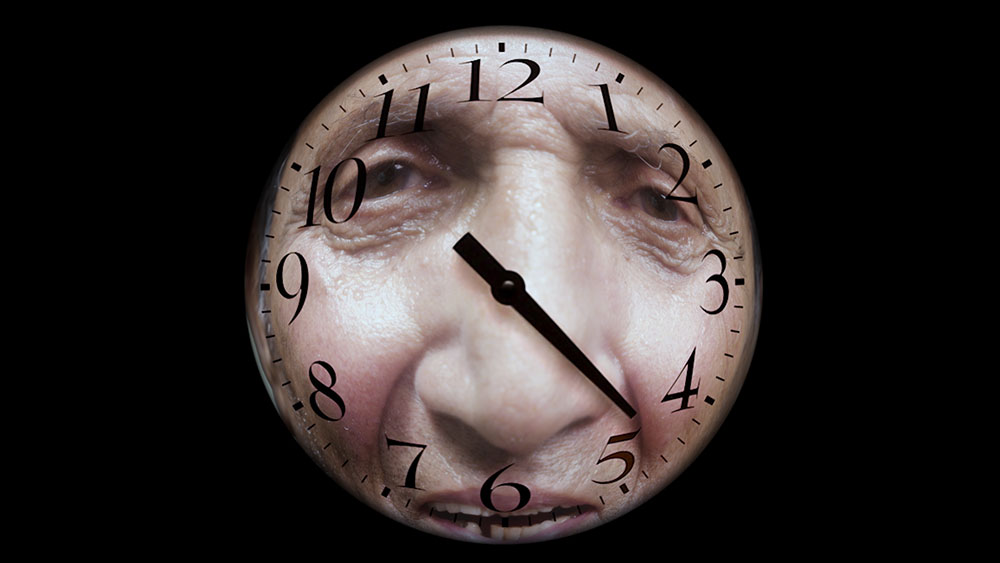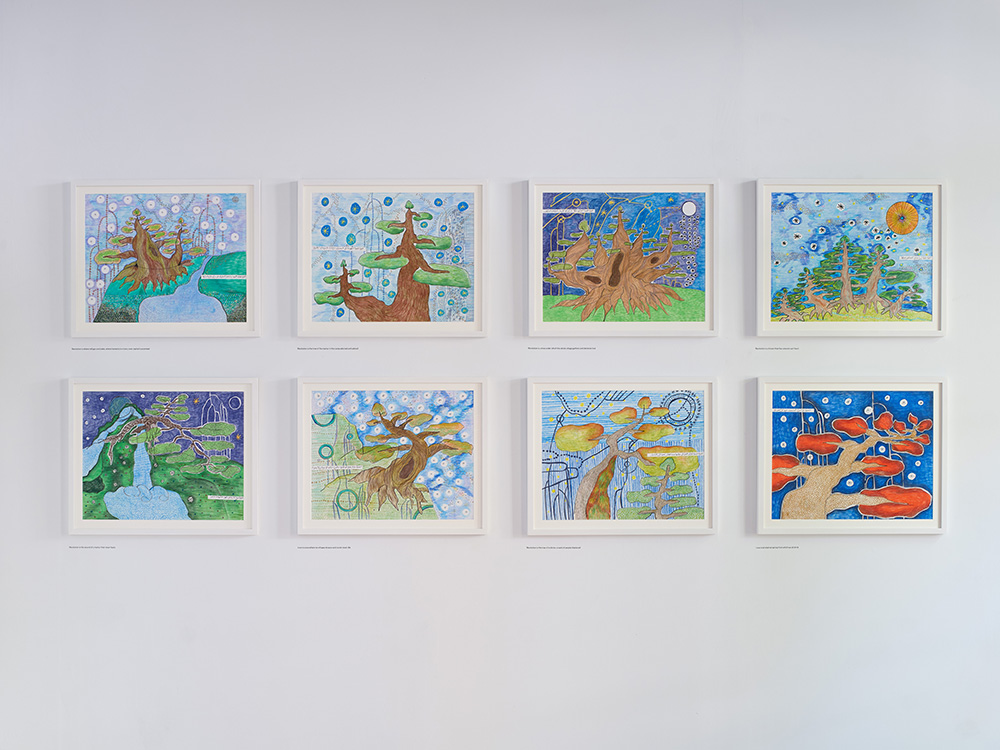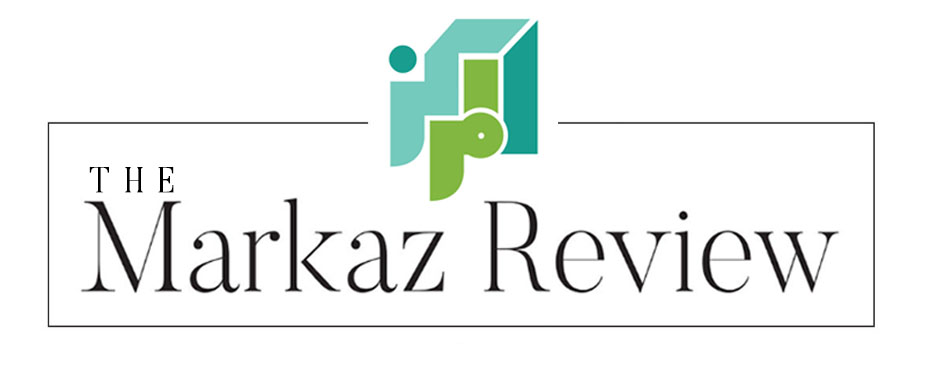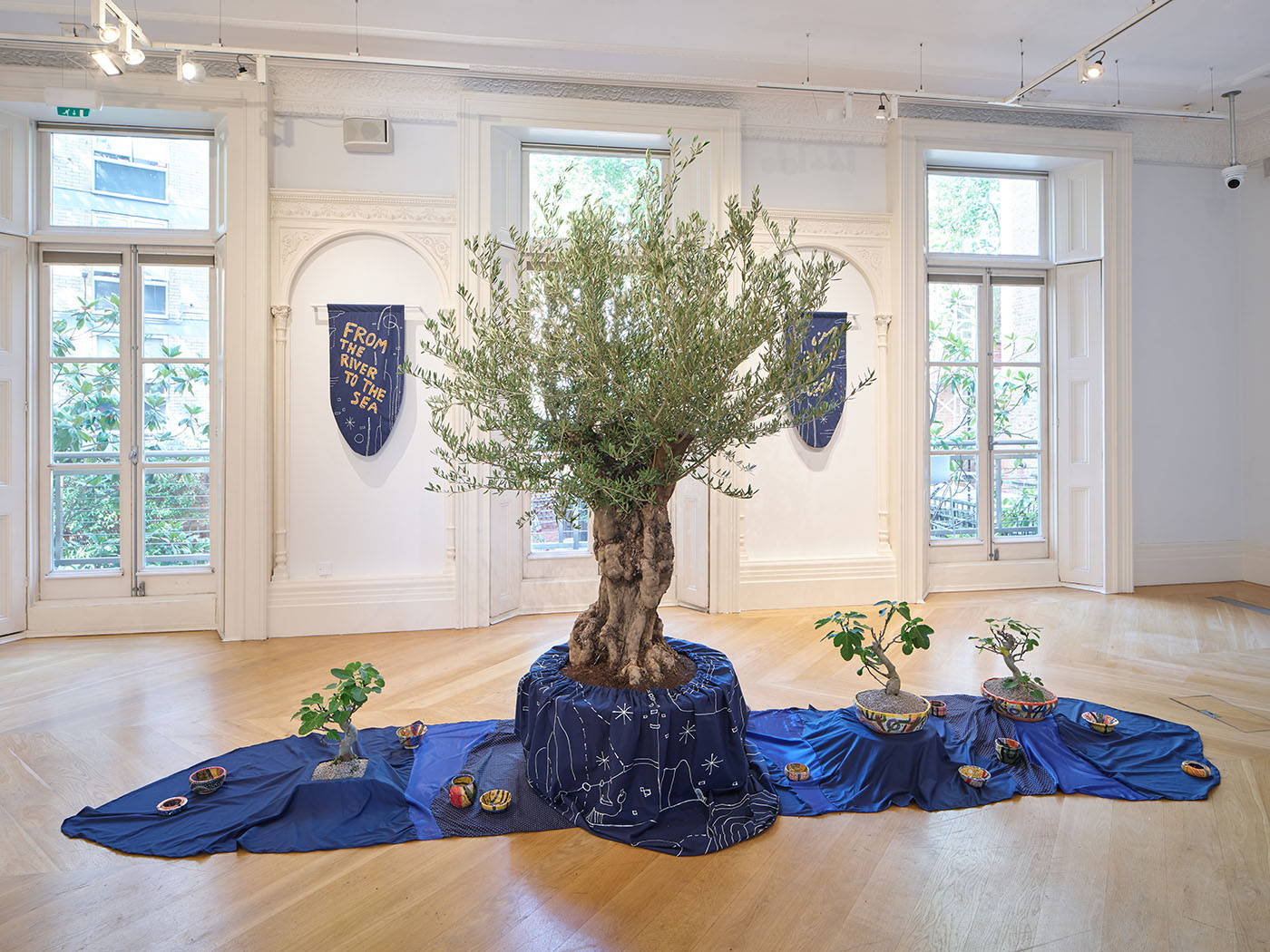The proposition of the In the Shade of the Sun exhibition itself, what Bilna’es stands for, and the generative possibilities of this approach is one that more artists and institutions could stand to emulate, and certainly demonstrates the possibilities that the essential work of collaboration and community-building can generate.
Nadine Nour el Din
In Xaytun Ennasr’s sprawling installation, a large potted olive tree greets visitors to The Mosaic Rooms’ elegant townhouse. The tree is surrounded by delicate painted ceramics and smaller saplings; framing the room are a series of dreamy mixed media drawings of trees and stars, including a poem, excerpts of which read, “love is a galaxy in which all suns orbit, for each revolutionary is a lover,” and, “revolution is a forest that the colonist can’t burn.” Glittery, hand-embroidered wall hangings read “from the river to the sea” in sequined script, and a video game produced with the artist’s brother invites players to plant endless trees.
You can hear Tomorrow, again (2023) the video work by Mona Benyamin before you step into the darkened front room to watch it — a surreal, absurdist film at once funny and unsettling. Taking the form of a news broadcast that casts the artist’s parents as the central protagonists, Benyamin distorts and exaggerates events and emotions. A ticker reads “what is happening in Palestine” while presenters on a roundtable scream, eyewitness testimonies contradict to the point of senselessness and what starts as laughter turns jarringly dire. Dina Mimi’s two channel video installation The melancholy of this useless afternoon (2023) takes over the bottom floor, layering the research-based stories of birdsong competitions and bird smugglers in two chapters. This is presented alongside a framed cotton shirt enmeshed in plants, emulating a bird-smuggling costume.
These works by the three emerging Palestinian artists — Ennasr, Benyamin, and Mimi — were commissioned especially by Bilna’es (“in the negative”), a publishing platform initiated by artist duo Basel Abbas and Ruanne Abou-Rahme, in association with musician Muqata’a and other anonymous figures, as a way to support artistic communities in Palestine and beyond. The resulting exhibition is In the Shade of the Sun, on view at The Mosaic Rooms in London through January 14, 2024. It has largely been well received, celebrated for showcasing fresh voices from a new generation of artists from Palestine, though at least one critic expressed ambivalence, having missed the context of the works and exhibition.
Though In the Shade of the Sun was staged ahead of the Israeli assault on the Gaza Strip and involved many months of planning beforehand, the works on view nevertheless address the realities of life under occupation, lending the exhibition a renewed sense of urgency. Independent researcher and curator Adam HajYahya’s accompanying program has sensitively responded to current events, including a recent panel discussion on institutional politics and cultural work addressing recent incidents of censorship and the precarious politics of arts institutions globally.

Originally, Basel Abbas and Ruanne Abou-Rahme had themselves been invited by The Mosaic Rooms to present an exhibition of their own work. Instead, they proposed to mount an exhibition through Bilna’es and offer the opportunity of a show to young, emerging artists — in counterpoint to the perpetual gatekeeping of the art world. An interdisciplinary platform, Bilna’es began in 2020, with the explicit mission of finding new models for artists to redistribute resources and support one another both in the production and circulation of work. The duo, who divide their time between Ramallah and New York, work across sound, image, filmmaking, installation and performance practices. In the context of occupation, colonization, and apartheid, their work, and more broadly their initiation of Bilna’es, engages with one fundamental question: “What are the tools that we can use to not just survive, but also generate different [political and artistic] possibilities?”1
One of the answers is to broaden the platforms available to as diverse a group of artists as possible. Hailing from different cities in Palestine, Washington, DC-based multidisciplinary artist and designer Xaytun Ennasr who studied in Jenin, visual artist and filmmaker Dina Mimi, based between Jerusalem and Amsterdam, and Haifa-based visual artist and filmmaker Mona Benyamin were thoughtfully brought together to exhibit new works for the first time in London. Ramallah-based music performer Makimakkuk was also set to stage a performance addressing identity, colonization, love, and relationships, but, denied a visa to the UK she was ultimately unable to realize her commission. Each of the artists’ respective practices speaks in some way to that of Abbas and Abou-Rahme’s, particularly Abbas’ background in sound and music production and Abou-Rahme’s writing and filmmaking expertise. Bilna’es also commissioned Haitham Haddad of Studio Mnjnk to design the exhibition poster and visual identity, and Adam HajYahia was invited to curate the public program.
The exhibition feels like an experiment of sorts and, given that it presents a cohort of Bilna’es artists that have each been coaxed and nurtured by Abass and Abou-Rahme, evokes the feeling of a graduate show. Much like a grad show, it carries an air of promise, a place to discover young emerging artists whose bright careers have yet to come to fruition. Through the series of works presented, each of these artists appear to be in the process of developing the visual language to articulate their ideas, one, as Ennasr frames in an intriguing paradox, of “radically soft” resistance. There is some element of search in each of their respective practices — contending with their ideas around Palestinian aesthetics and politics and the ways in which to express them — most evident when they spoke about their work in an artist breakfast and tour of the exhibition following the opening.

Reluctant to claim curatorial credit, Abbass and Abou-Rahme present this show instead as a collaboration between The Mosaic Rooms and Bilna’es. This is very much reflected in the exhibition, sometimes to its detriment. There is a felt lack of cohesive narrative. For instance, a most compelling absent thread is that each of the artists is from a different part of occupied Palestine, and each of them lives in diaspora, practices in a different city — all brought together in London where they are exhibiting for the first time and brought together as a collective for the first time (though some knew of each other). It feels like a missed opportunity to highlight the power dynamics at stake; the way that the occupation of Palestine creates a scattering, so that Palestinian artists somehow need an initiative like Bina’es that can bridge the geographical, psychological, and logistical gaps created by the occupation. This is further exacerbated by the response to Makkimakuk’s absence, addressed in a statement by Bilna’es, but given that no alternative way to present her work was proposed, she disappointingly ended up being excluded entirely as a result. The main element of the show is Bilna’es, or rather, their initiative and the ideas that animate it, but beyond a credit in the wall text near the entrance, there is little else to discover without deeper excavation.
The fact of “being in the negative,” from which Bilna’es’ name and philosophy are derived is described by Abbbas and Abou-Rahme as the act of “breathing where you should not be able to breathe.”2 As HajYahya elucidates in a commissioned text accompanying the exhibition, “this negative is where what is rendered impossible is fractured by possibility, and what is excluded finds a new form of being and breathing — within and despite of the exclusion.”3 Given that Bilna’es have been active primarily through publishing artistic works ranging from music to video games, web projects, performances, publications and installations, I would have loved to see some of their work with musicians highlighted, and to have had the opportunity to listen to some of the albums, or perhaps explore the earlier series of video games by Xaytun Ennasr Nothing Old, Nothing New (2021) whose work is presented in the show.
Still, the proposition of the exhibition itself, what Bilna’es stands for, and the generative possibilities of this approach is one that more artists and institutions could stand to emulate, and certainly demonstrates the possibilities that the essential work of collaboration and community-building can generate. This type of initiative generously allows less experienced artists a way in, offering meaningful exposure, sustaining resources, and thoughtful guidance. This is particularly significant in the case of Palestinian artists, where works and people may not have otherwise come together because of the checkpoints enforced by the occupation, both physical and psychological. What if more artists thought to hold the door open? What if more institutions prioritized opportunities for co-creation and collaboration, over mounting the same exhibitions and events by the same established artists? Building community has never been more vital, especially in a moment when artists and cultural workers are being censored for their views. Forged tirelessly in the shade of the sun, and under the glare of the moon, alternative systems that platform disadvantaged voices and share resources in meaningful ways can chart a path forward.4 As bell hooks reminds us, “one of the most vital ways we sustain ourselves is by building communities of resistance, places where we know we are not alone.”5
Notes
1. Basel Abbass and Ruanne Abou-Rahme in Morgan King, “An Archive That’s Only Written through and by Power Is a Closed, Static, Even Dead Archive,” MoMA | Art and artists, 2021.
2. Basel Abbas, in Amal Issa, “Being in the negative: An interview with Basel Abbas and Ruanne Abou-Rahme,” Perpetual Postponement, 29 June 2020.
3. Adam HajYahya, “Under the glare of the moon: aesthetic lineages of revolt,” The Mosaic Rooms, 2023.
4. Adam HajYahya, “Under the glare of the moon: aesthetic lineages of revolt,” The Mosaic Rooms, 2023.
5. bell hooks, Yearning: Race, Gender, and Cultural Politics, p.227, Routledge (2014).




